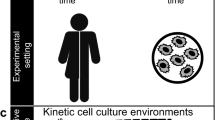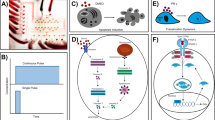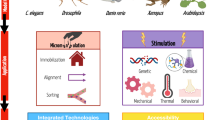Abstract
Microfluidics coupled to quantitative time-lapse fluorescence microscopy is transforming our ability to control, measure and understand signaling dynamics in single living cells. Here we describe a pipeline that incorporates multiplexed microfluidic cell culture, automated programmable fluid handling for cell perturbation, quantitative time-lapse microscopy and computational analysis of time-lapse movies. We illustrate how this setup can be used to control the nuclear localization of the budding yeast transcription factor Msn2. By using this protocol, we generate oscillations of Msn2 localization and measure the dynamic gene expression response of individual genes in single cells. The protocol allows a single researcher to perform up to 20 different experiments in a single day, while collecting data for thousands of single cells. Compared with other protocols, the present protocol is relatively easy to adopt and of higher throughput. The protocol can be widely used to control and monitor single-cell signaling dynamics in other signal transduction systems in microorganisms.
This is a preview of subscription content, access via your institution
Access options
Subscribe to this journal
Receive 12 print issues and online access
$259.00 per year
only $21.58 per issue
Buy this article
- Purchase on Springer Link
- Instant access to full article PDF
Prices may be subject to local taxes which are calculated during checkout







Similar content being viewed by others
References
Selimkhanov, J. et al. Accurate information transmission through dynamic biochemical signaling networks. Science 346, 1370–1373 (2014).
Batchelor, E., Loewer, A., Mock, C. & Lahav, G. Stimulus-dependent dynamics of p53 in single cells. Mol. Syst. Biol. 7, 488 (2011).
Cai, L., Dalal, C.K. & Elowitz, M.B. Frequency-modulated nuclear localization bursts coordinate gene regulation. Nature 455, 485–90 (2008).
Hao, N., Budnik, B.A., Gunawardena, J. & O′Shea, E.K. Tunable signal processing through modular control of transcription factor translocation. Science 339, 460–464 (2013).
Yissachar, N. et al. Dynamic response diversity of NFAT isoforms in individual living cells. Mol. Cell 49, 322–330 (2013).
Cai, H.Q. et al. Nucleocytoplasmic shuttling of a GATA transcription factor functions as a development timer. Science 343, 1249531 (2014).
Hersen, P., McClean, M.N., Mahadevan, L. & Ramanathan, S. Signal processing by the HOG MAP kinase pathway. Proc. Natl. Acad. Sci. USA 105, 7165–7170 (2008).
Imayoshi, I. et al. Oscillatory control of factors determining multipotency and fate in mouse neural progenitors. Science 342, 1203–1208 (2013).
Spiller, D.G., Wood, C.D., Rand, D.A. & White, M.R.H. Measurement of single-cell dynamics. Nature 465, 736–745 (2010).
Behar, M. & Hoffmann, A. Understanding the temporal codes of intra-cellular signals. Curr. Opin. Genet. Dev. 20, 684–693 (2010).
Levine, J.H., Lin, Y.H. & Elowitz, M.B. Functional roles of pulsing in genetic circuits. Science 342, 1193–1200 (2013).
Purvis, J.E. & Lahav, G. Encoding and decoding cellular information through signaling dynamics. Cell 152, 945–56 (2013).
Castillo-Hair, S.M., Igoshin, O.A. & Tabor, J.J. How to train your microbe: methods for dynamically characterizing gene networks. Curr. Opin. Microbiol. 24C, 113–123 (2015).
Sanchez, A. & Golding, I. Genetic determinants and cellular constraints in noisy gene expression. Science 342, 1188–93 (2013).
Bennett, M.R. & Hasty, J. Microfluidic devices for measuring gene network dynamics in single cells. Nat. Rev. Genet. 10, 628–638 (2009).
Ferry, M.S., Razinkov, I.A. & Hasty, J. Microfluidics for synthetic biology: from design to execution. Methods Enzymol. 497, 295–372 (2011).
Sackmann, E.K., Fulton, A.L. & Beebe, D.J. The present and future role of microfluidics in biomedical research. Nature 507, 181–189 (2014).
Denervaud, N. et al. A chemostat array enables the spatio-temporal analysis of the yeast proteome. Proc. Natl. Acad. Sci. USA 110, 15842–15847 (2013).
Hansen, A.S. & O′Shea, E.K. Promoter decoding of transcription factor dynamics involves a trade-off between noise and control of gene expression. Mol. Syst. Biol. 10.1038/msb.2013.56 (5 November 2013).
Tseng, P., Weaver, W.M., Masaeli, M., Owsley, K. & Di Carlo, D. Research highlights: microfluidics meets big data. Lab Chip 14, 828–32 (2014).
Hansen, A.S. & O'Shea, E.K. Limits on information transduction through amplitude and frequency regulation of transcription factor activity. Elife 10.7554/eLife.06559 (18 May 2015).
Prindle, A. et al. Rapid and tunable post-translational coupling of genetic circuits. Nature 508, 387–391 (2014).
Uhlendorf, J. et al. Long-term model predictive control of gene expression at the population and single-cell levels. Proc. Natl. Acad. Sci. USA 109, 14271–14276 (2012).
Menolascina, F. et al. In vivo real-time control of protein expression from endogenous and synthetic gene networks. PLoS Comput. Biol. 10, e1003625 (2014).
Sorre, B., Warmflash, A., Brivanlou, A.H. & Siggia, E.D. Encoding of temporal signals by the TGF-β pathway and implications for embryonic patterning. Dev. Cell 30, 334–342 (2014).
Hao, N. et al. Regulation of cell signaling dynamics by the protein kinase-scaffold Ste5. Mol. Cell 30, 649–56 (2008).
Mettetal, J.T., Muzzey, D., Gomez-Uribe, C. & van Oudenaarden, A. The frequency dependence of osmo-adaptation in Saccharomyces cerevisiae. Science 319, 482–484 (2008).
Hao, N. & O'Shea, E.K. Signal-dependent dynamics of transcription factor translocation controls gene expression. Nat. Struct. Mol. Biol. 19, 31–39 (2012).
Cohen, M.S., Ghosh, A.K., Kim, H.J., Jeon, N.L. & Jaffrey, S.R. Chemical genetic-mediated spatial regulation of protein expression in neurons reveals an axonal function for Wld(S). Chem. Biol. 19, 179–187 (2012).
Bennett, M.R. et al. Metabolic gene regulation in a dynamically changing environment. Nature 454, 1119–1122 (2008).
Gorner, W. et al. Nuclear localization of the C2H2 zinc finger protein Msn2p is regulated by stress and protein kinase A activity. Genes Dev. 12, 586–97 (1998).
Bishop, A.C. et al. A chemical switch for inhibitor-sensitive alleles of any protein kinase. Nature 407, 395–401 (2000).
Zaman, S., Lippman, S.I., Schneper, L., Slonim, N. & Broach, J.R. Glucose regulates transcription in yeast through a network of signaling pathways. Mol. Syst. Biol. 5, 245 (2009).
Filonov, G.S. et al. Bright and stable near-infrared fluorescent protein for in vivo imaging. Nat. Biotechnol. 29, 757–761 (2011).
Elowitz, M.B., Levine, A.J., Siggia, E.D. & Swain, P.S. Stochastic gene expression in a single cell. Science 297, 1183–1186 (2002).
Agrawal, B.B.L. & Goldstein, I.J. Protein-carbohydrate interaction : VII. Physical and chemical studies on concanavalin A, the hemagglutinin of jack bean. Arch. Biochem. Biophys. 124, 218–229 (1968).
Senear, D.F. & Teller, D.C. Thermodynamics of concanavalin-A dimer-tetramer self-association: sedimentation equilibrium studies. Biochemistry 20, 3076–3083 (1981).
Bisaria, A., Hersen, P. & McClean, M.N. Microfluidic platforms for generating dynamic environmental perturbations to study the responses of single yeast cells. Methods Mol. Biol. 1205, 111–129 (2014).
Strack, R.L., Song, W.J. & Jaffrey, S.R. Using spinach-based sensors for fluorescence imaging of intracellular metabolites and proteins in living bacteria. Nat. Protoc. 9, 146–155 (2014).
Bermejo, C., Haerizadeh, F., Takanaga, H., Chermak, D. & Frommer, W.B. Optical sensors for measuring dynamic changes of cytosolic metabolite levels in yeast. Nat. Protoc. 6, 1806–1817 (2011).
Dean, K.M. & Palmer, A.E. Advances in fluorescence labeling strategies for dynamic cellular imaging. Nat. Chem. Biol. 10, 512–523 (2014).
Huh, W.K. et al. Global analysis of protein localization in budding yeast. Nature 425, 686–691 (2003).
Petrenko, N., Chereji, R.V., McClean, M.N., Morozov, A.V. & Broach, J.R. Noise and interlocking signaling pathways promote distinct transcription factor dynamics in response to different stresses. Mol. Biol. Cell 24, 2045–2057 (2013).
Zid, B.M. & O′Shea, E.K. Promoter sequences direct cytoplasmic localization and translation of mRNAs during starvation in yeast. Nature 514, 117–121 (2014).
Paige, J.S., Nguyen-Duc, T., Song, W.J. & Jaffrey, S.R. Fluorescence imaging of cellular metabolites with RNA. Science 335, 1194–1194 (2012).
Westfall, P.J. & Thorner, J. Analysis of mitogen-activated protein kinase signaling specificity in response to hyperosmotic stress: use of an analog-sensitive HOG1 allele. Eukaryot. Cell 5, 1215–28 (2006).
Liu, Y. et al. Two cyclin-dependent kinases promote RNA polymerase II transcription and formation of the scaffold complex. Mol. Cell. Biol. 24, 1721–1735 (2004).
Carroll, A.S., Bishop, A.C., DeRisi, J.L., Shokat, K.M. & O′Shea, E.K. Chemical inhibition of the Pho85 cyclin-dependent kinase reveals a role in the environmental stress response. Proc. Natl. Acad. Sci. USA 98, 12578–83 (2001).
Shirra, M.K. et al. A chemical genomics study identifies Snf1 as a repressor of GCN4 translation. J. Biol. Chem. 283, 35889–35898 (2008).
Elphick, L.M., Lee, S.E., Gouverneur, V. & Mann, D.J. Using chemical genetics and ATP analogues to dissect protein kinase function. ACS Chem. Biol. 2, 299–314 (2007).
Rakhit, R., Navarro, R. & Wandless, T.J. Chemical biology strategies for posttranslational control of protein function. Chem. Biol. 21, 1238–1252 (2014).
McIsaac, R.S. et al. Fast-acting and nearly gratuitous induction of gene expression and protein depletion in Saccharomyces cerevisiae. Mol. Biol. Cell 22, 4447–4459 (2011).
Haruki, H., Nishikawa, J. & Laemmli, U.K. The anchor-away technique: rapid, conditional establishment of yeast mutant phenotypes. Mol. Cell 31, 925–932 (2008).
Belshaw, P.J., Ho, S.N., Crabtree, G.R. & Schreiber, S.L. Controlling protein association and subcellular localization with a synthetic ligand that induces heterodimerization of proteins. Proc. Natl. Acad. Sci. USA 93, 4604–4607 (1996).
Geda, P. et al. A small molecule-directed approach to control protein localization and function. Yeast 25, 577–594 (2008).
Huberts, D.H.E.W. et al. Construction and use of a microfluidic dissection platform for long-term imaging of cellular processes in budding yeast. Nat. Protoc. 8, 1019–1027 (2013).
Crane, M.M., Clark, I.B., Bakker, E., Smith, S. & Swain, P.S. A microfluidic system for studying ageing and dynamic single-cell responses in budding yeast. PLoS ONE 9, e100042 (2014).
Rowat, A.C., Bird, J.C., Agresti, J.J., Rando, O.J. & Weitz, D.A. Tracking lineages of single cells in lines using a microfluidic device. Proc. Natl. Acad. Sci. USA 106, 18149–18154 (2009).
Taylor, R.J. et al. Dynamic analysis of MAPK signaling using a high-throughput microfluidic single-cell imaging platform. Proc. Natl. Acad. Sci. USA 106, 3758–3763 (2009).
Sott, K., Eriksson, E. & Goksor, M. Acquisition of single cell data in an optical microscope. in Lab on a Chip Technology: Biomolecular Separation and Analysis (Caister Academic Press, 2009).
Kellogg, R.A., Gomez-Sjoberg, R., Leyrat, A.A. & Tay, S. High-throughput microfluidic single-cell analysis pipeline for studies of signaling dynamics. Nat. Protoc. 9, 1713–1726 (2014).
Zhang, Y. et al. Single cell analysis of yeast replicative aging using a new generation of microfluidic device. PLoS ONE 7, e48275 (2012).
Lee, S.S., Avalos Vizcarra, I., Huberts, D.H., Lee, L.P. & Heinemann, M. Whole lifespan microscopic observation of budding yeast aging through a microfluidic dissection platform. Proc. Natl. Acad. Sci. USA 109, 4916–4920 (2012).
Xie, Z. et al. Molecular phenotyping of aging in single yeast cells using a novel microfluidic device. Aging Cell 11, 599–606 (2012).
Ryley, J. & Pereira-Smith, O.M. Microfluidics device for single cell gene expression analysis in Saccharomyces cerevisiae. Yeast 23, 1065–1073 (2006).
Lee, P.J., Helman, N.C., Lim, W.A. & Hung, P.J. A microfluidic system for dynamic yeast cell imaging. Biotechniques 44, 91–95 (2008).
McClean, M.N., Hersen, P. & Ramanathan, S. Measuring in vivo signaling kinetics in a mitogen-activated kinase pathway using dynamic input stimulation. Methods Mol. Biol. 734, 101–119 (2011).
Qin, D., Xia, Y. & Whitesides, G.M. Soft lithography for micro- and nanoscale patterning. Nat. Protoc. 5, 491–502 (2010).
Hillborg, H. et al. Crosslinked polydimethylsiloxane exposed to oxygen plasma studied by neutron reflectometry and other surface specific techniques. Polymer 41, 6851–6863 (2000).
McDonald, J.C. et al. Fabrication of microfluidic systems in poly(dimethylsiloxane). Electrophoresis 21, 27–40 (2000).
Sheff, M.A. & Thorn, K.S. Optimized cassettes for fluorescent protein tagging in Saccharomyces cerevisiae. Yeast 21, 661–670 (2004).
Wang, J.D., Douville, N.J., Takayama, S. & ElSayed, M. Quantitative analysis of molecular absorption into PDMS microfluidic channels. Ann. Biomed. Eng. 40, 1862–1873 (2012).
Gordon, A. et al. Single-cell quantification of molecules and rates using open-source microscope-based cytometry. Nat. Methods 4, 175–181 (2007).
Lamprecht, M.R., Sabatini, D.M. & Carpenter, A.E. CellProfiler(TM): free, versatile software for automated biological image analysis. Biotechniques 42, 71–75 (2007).
Doncic, A., Eser, U., Atay, O. & Skotheim, J.M. An algorithm to automate yeast segmentation and tracking. PLoS ONE 8, e57970 (2013).
Grote, A. et al. JCat: a novel tool to adapt codon usage of a target gene to its potential expression host. Nucleic Acids Res. 33, W526–W531 (2005).
Kremers, G.J., Goedhart, J., van Munster, E.B. & Gadella, T.W.J. Cyan and yellow super fluorescent proteins with improved brightness, protein folding, and FRET Forster radius. Biochemistry 45, 6570–6580 (2006).
Zechner, C., Unger, M., Pelet, S., Peter, M. & Koeppl, H. Scalable inference of heterogeneous reaction kinetics from pooled single-cell recordings. Nat. Methods 11, 197–202 (2014).
Acknowledgements
We thank M. McClean and S. Ramanathan for their help with setting up the original Y-channel microfluidic device. We thank D. MacLaurin and E. Zwiebach-Cohen for discussions. We thank the O'Shea laboratory for discussions and comments on the manuscript. This work was performed in part at the Center for Nanoscale Systems at Harvard University, a member of the National Nanotechnology Infrastructure Network, which is supported by the National Science Foundation under NSF award no. ECS-0335765. This work was supported by the Howard Hughes Medical Institute (to E.K.O'S.) and the US National Institutes of Health grant R01 GM111458 (to N.H.).
Author information
Authors and Affiliations
Contributions
A.S.H. developed the multiplexed microfluidic device, the automated fluid control system, developed MATLAB code and wrote the protocol. N.H. developed the original method of using microfluidics to control analog-sensitive kinases and Msn2 localization. E.K.O'S. supervised the projects. A.S.H., N.H. and E.K.O'S. wrote the manuscript.
Corresponding author
Ethics declarations
Competing interests
The authors declare no competing financial interests.
Integrated supplementary information
Supplementary Figure 1 Control experiment for Figure 2.
Figure 2 shows a typical experiment for strain EY2967/ASH189 in response to six 5-min pulses of 690 nM 1-NM-PP1 separated by 10- min intervals. This figure shows the same plots with the same axes for a control experiment without 1-NM-PP1 treatment. As can be seen, in the absence of 1-NM-PP1 treatment, no gene expression is observed.
a) Msn2 translocation dynamics. In this control experiment, no 1-NM-PP1 is added, so no Msn2-mCherry activation is observed. Raw data (black dots) and errorbars (standard deviation) are from 101 single cells and the red line shows a fit to the data.
b)-c) Single cell time traces of the YFP (b) and CFP (c) gene expression reporters. Raw, unsmoothed data is shown. As can be seen, in the absence of 1-NM-PP1 treatment, no gene expression is observed.
d) By following both CFP and YFP gene expression dynamics in the same single cell, their co-variance can be computed. Each dot in the scatterplot is the max CFP and YFP from the same single cell.
Supplementary information
Supplementary Text and Figures
Supplementary Figure 1, Supplementary Tutorials 1 and 2 (PDF 1686 kb)
Supplementary Data 1: Transparency mask
Raw transparency mask file in ‘.eps’ format. (ZIP 349 kb)
Supplementary Data 2: Valve control scripts
A zip-compressed folder containing MATLAB scripts for controlling and interfacing with solenoid electrovalves as described in Box 1 and Supplementary Tutorial 1. (ZIP 3 kb)
Supplementary Data 3: Image analysis scripts
A zip-compressed folder containing MATLAB scripts for image analysis as described in Supplementary Tutorial 2. (ZIP 123 kb)
Supplementary Data 4: Microscope holder
Microscope holder sketch in ‘PDF’ format. (PDF 264 kb)
Rights and permissions
About this article
Cite this article
Hansen, A., Hao, N. & O'Shea, E. High-throughput microfluidics to control and measure signaling dynamics in single yeast cells. Nat Protoc 10, 1181–1197 (2015). https://doi.org/10.1038/nprot.2015.079
Published:
Issue Date:
DOI: https://doi.org/10.1038/nprot.2015.079
This article is cited by
-
Microfluidic dose–response platform to track the dynamics of drug response in single mycobacterial cells
Scientific Reports (2022)
-
Three-dimensional localization microscopy in live flowing cells
Nature Nanotechnology (2020)
-
Cell trapping microfluidic chip made of Cyclo olefin polymer enabling two concurrent cell biology experiments with long term durability
Biomedical Microdevices (2020)
-
MMHelper: An automated framework for the analysis of microscopy images acquired with the mother machine
Scientific Reports (2019)
-
An integrated microfluidic device for the sorting of yeast cells using image processing
Scientific Reports (2018)
Comments
By submitting a comment you agree to abide by our Terms and Community Guidelines. If you find something abusive or that does not comply with our terms or guidelines please flag it as inappropriate.



